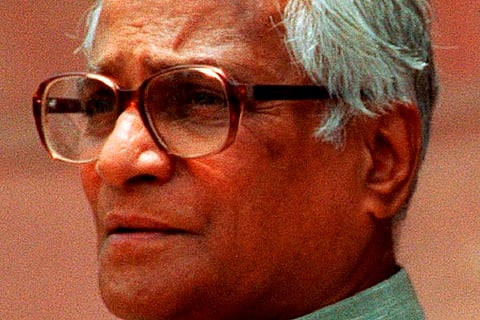

I have been receiving a series of tweets referring to writings somewhere on purported statements by George Fernandes when the Godhra train-burning and subsequent rioting took place. Unknown tweeters are rightly curious about whether George Fernandes ever said that he wished the army had been called into Gujarat and if he seemed to be at odds with Narendra Modi, the Chief Minister of Gujarat at that time. These persons have appealed to me to clarify or certify what George Fernandes said. If this has indeed been written somewhere, it is nothing but a distortion of fact, or, as it is now known, a “post truth”.
Having been a close witness to the actual events on the day after the Hindu extremist bandh in Gujarat protesting the burning of kar sevaks in the Godhra train, it is necessary to share the sequence of events of that time.
The burning of the train came as shocking news to everyone. However, a strange atmosphere overtook Parliament, which was in session. There was uproar from the treasury benches of the NDA government, as many members called for a unanimous resolution condemning the burning of so many people in one compartment of a train. Stubbornly, the Congress Party members folded their arms against their chests and refused. Dr. Betty D’Souza, Samata Party MP, came out and joined me at my office at No. 3, Krishna Menon Marg to describe this. She was frustrated and irritated that a logjam was being created in Parliament on a matter that required unity of voice. The Congress pointedly refused, saying to the treasury benches, “You are making enough noise on behalf of all of us.”
A collective political voice never emerged. Most newspapers wrote editorials at that time practically saying that the kar sevaks deserved what they got for having destroyed the Babri Masjid. One interesting and heartening exception was Vir Sanghvi’s bold and fair piece as the Editor of the Hindustan Times saying nothing can justify such barbarity. However, in the absence of a unified voice condemning the burning and calling for peace and unity, a bandh was called by the Bajrang Dal and other extremist Hindu groups in Gujarat.
On the next day, trouble erupted all over. In the evening, George Fernandes was sitting with the Prime Minister Atal Bihari Vajpayee at No. 10, Race Course Road, discussing the day’s events, when a fax arrived at PM House from the Chief Minister of Gujarat requesting the deployment of the army in Ahmedabad. Fernandes came away to his residential office, shared this news with me and his personal staff and ordered for concerned officers to reach Raksha Bhavan immediately. The troops were at that time deployed on a special exercise called Operation Parikrama on the Rajasthan border. They had to be called back. They were re-deployed during the night and put on flights by 1.30am, if I recall correctly.
George Fernandes stayed at Raksha Bhavan for most of the night and himself left for Ahmedabad on the early morning flight. He was soon on the streets of Ahmedabad standing in a truck among the troops. The army helped families escape violent crowds, of which photographs appeared in The Economic Times and others. Harsh Sethi, a well-known Left intellectual wrote in a centre piece in The Hindu sometime later that the army coming out under George Fernandes saved thousands of lives. I know for a fact that Narendra Modi was in constant touch with the Defence Minister and even supported and co-operated when he later organised a citizen’s peace march of 7000 people, including Muslims, through the city. I too was present. Modi addressed the marchers at the end of its journey, thanking everyone for working towards peace. Interestingly, some newspapers reported this totally peaceful and uneventful march the next day with the headline “Fernandes’ peace march walks over dead bodies”. There was not a moment’s tension or frustration in the relationship between Modi and Fernandes, whether before or after, and this is a fact even if this has annoyed many Modi-haters and some of Fernandes’ socialist compatriots.
There could be no reason, as has apparently been stated, for the Defence Minister to wish that the army had been sent to Gujarat when it was in fact asked for immediately, and sent under his very leadership.
On a later visit to Gujarat in an all-party delegation in which Sonia Gandhi was also a member, I was confronted by a belligerent youth activist of the Bajrang Dal who asked me to tell George Fernandes to stay away from interfering. I answered that he was no one to speak to me and that George Sahib was asked by the Chief Minister to assist in quelling the riots, and he had responded as was his national duty.
These are the facts from personal knowledge which should help in dispelling any new interpretations of George Fernandes, especially since he is incapable of clarifying such a controversial recounting of significant events in his present state of mental health.